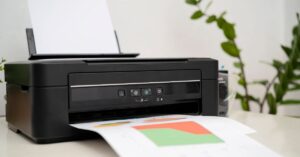Printing has evolved far beyond ink on paper, offering a vast range of techniques that bring designs to life in unique ways. From traditional methods like offset and screen printing to cutting-edge 3D and digital printing, each type serves a specific purpose.
Whether you’re a designer, business owner, or just curious about the craft, this guide will break down 24 types of printing to help you choose the best method for your next project. Dive in and discover the power of print!
Types of Printing
Here are the primary types of printing, each serving distinct purposes and suited for different materials and quantities:
1. Digital Printing
Digital printing operates similarly to your home printer but on a grander scale. This method directly transfers digital images onto the chosen medium. It’s the best option for situations requiring quick turnaround times and smaller quantities, such as business cards, flyers, and personalized invitations.
Digital printing offers unparalleled flexibility, allowing for easy customization and on-demand printing. This makes it ideal for projects with variable data, where each piece might have unique elements like names or addresses. This technique has also made significant strides in color accuracy, rivaling traditional methods in many applications.
- Pros: Quick setup with high customization.
- Cons: Not ideal for large-scale print runs.
- Best used for: Business cards, flyers, personalized invitations.
2. Screen Printing
Screen printing involves creating a stencil (or screen) and applying layers of ink to the printing surface. This technique is particularly favored for clothing, posters, and banners due to its ability to produce bright colors and durable prints.
The versatility of screen printing extends beyond fabrics and paper. It’s also employed for printing on glass, wood, and even electronics, making it a go-to method for a wide range of industries.
Screen printing also allows for the use of specialty inks, such as glow-in-the-dark or textured finishes, adding unique dimensions to your printed materials.
- Pros: Vibrant colors and durable prints.
- Cons: Time-consuming setup for small orders.
- Best used for: Clothing, posters, banners.
3. Flexography
Flexography, often called flexo, utilizes flexible plates to print on various materials, including plastics, metallic films, and paper. Its functionality resembles a rubber stamp, making it perfect for packaging and labels.
This method shines in its ability to print on uneven surfaces, a feature particularly valuable in the food and beverage industry for printing on bottles and irregular containers. Its quick-drying inks make it suitable for high-speed production lines, enhancing efficiency in large-scale manufacturing processes.
- Pros: Fast, efficient for uneven surfaces.
- Cons: Limited to simpler color designs.
- Best used for: Packaging, labels, food containers.
4. Lithography
Lithography works based on the principle that oil and water do not mix. Images are drawn with oil-based ink on a flat surface, water is applied, and the inked image is transferred onto paper. This method is used in high-volume printing, such as posters, maps, and packaging.
One of lithography’s standout features is its ability to reproduce fine details and subtle tones, making it a preferred choice for artistic reproductions and high-quality photographic prints. The technique offers excellent color consistency across large print runs, ensuring uniformity in mass-produced materials like magazines and catalogs.
- Pros: High detail and color consistency.
- Cons: Expensive for short runs.
- Best used for: Posters, catalogs, maps.
5. 3D Printing
3D printing, also known as additive manufacturing, creates three-dimensional objects by layering material. This innovative technique has transformed prototyping, medical device production, and custom part creation.
The applications of 3D printing continue to expand, reaching into fields such as architecture, where it’s used to create detailed models, and even culinary arts, with chefs using it to craft intricate food designs.
3D printing is also adopted in sustainable manufacturing, allowing for the creation of complex structures with minimal waste.
- Pros: Creates complex, custom objects.
- Cons: Slow production speed.
- Best used for: Prototypes, medical devices, custom parts.
6. Offset Printing
Offset printing stands as the most common method for high-volume printing. It employs plates, typically made of aluminum, that transfer ink onto a rubber blanket and then onto the printing surface. This technique is ideal for producing high-quality prints like books, newspapers, and brochures.
One of offset printing’s key advantages is its cost-effectiveness for large print runs. As the quantity increases, the cost per unit decreases significantly. It also offers unparalleled control over color balance and ink distribution, resulting in crisp, clean prints that maintain their quality even in extensive production runs.
- Pros: Cost-effective for large volumes.
- Cons: Long setup time for small orders.
- Best used for: Newspapers, books, brochures.
7. Sublimation Printing
Sublimation printing uses heat to transfer dye onto fabric, plastic, or metal. This method creates bright, long-lasting designs on items such as t-shirts, mugs, and signs.
A notable benefit of sublimation printing is its ability to produce full-color images with no raised surfaces, resulting in a smooth, seamless finish that’s resistant to cracking or peeling. This technique also allows for edge-to-edge printing on products, maximizing the design area and creating striking, all-over prints.
- Pros: Full-color, durable designs.
- Cons: Limited to polyester or coated surfaces.
- Best used for: T-shirts, mugs, signs.
8. Large Format Printing
Large format printing produces prints on a grand scale, such as banners, posters, and billboards. This method employs special printers capable of handling oversized materials, delivering high-impact visuals for advertising and displays.
Beyond traditional applications, large format printing has found its place in interior design, creating custom wallpapers and murals that transform spaces. It’s also become integral in trade show and event marketing, allowing companies to create immersive brand experiences through expansive, high-quality graphics.
- Pros: High-quality, large-scale prints.
- Cons: Expensive for small-scale projects.
- Best used for: Banners, posters, billboards.
9. Display Print
Display printing creates high-quality visuals for exhibitions, trade shows, and retail environments. It encompasses large format and digital printing methods to produce bright and detailed graphics.
This versatile printing category has expanded to include interactive displays, incorporating elements like QR codes or augmented reality markers that engage viewers beyond the visual aspect.
Display printing also plays a key role in creating cohesive brand experiences, from storefront windows to in-store signage, ensuring consistent visual communication across various touchpoints.
- Pros: Eye-catching, high-detail graphics.
- Cons: Limited portability due to size.
- Best used for: Trade shows, exhibitions, retail displays.
10. Letterpress Printing
Letterpress printing involves pressing inked, raised surfaces onto paper. As one of the oldest printing techniques, it’s cherished for its tactile quality and classic look, often employed for wedding invitations and business cards.
The charm of letterpress extends beyond its visual appeal; the deep impressions left by the press create a three-dimensional effect that engages the sense of touch. This technique has seen a resurgence in the digital age, with artisans combining traditional methods with modern design software to create unique, handcrafted prints that stand out in a sea of mass-produced materials.
- Pros: Tactile, elegant finish.
- Cons: Higher costs and longer setup times.
- Best used for: Wedding invitations, business cards, stationery.
11. Transfer Printing
Transfer printing involves printing a design onto a special piece of paper and then transferring it onto the final surface using heat and pressure. This method is commonly used to create custom apparel and promotional items.
One of the advantages of transfer printing is its ability to produce high-quality, full-color images on dark or colored materials, where direct printing might not achieve the desired brightness.
This technique has also found applications in the home decor industry, allowing for the customization of items like throw pillows and curtains with intricate, photo-quality designs.
- Pros: Excellent for dark fabrics.
- Cons: Design may fade after washing.
- Best used for: Custom apparel, promotional items, home decor.
12. Inkjet Printing
Inkjet printing uses tiny droplets of ink to create images on paper. Its versatility makes it suitable for everything from office documents to photo printing.
Recent advancements in inkjet technology have expanded its capabilities to include printing on fabrics, creating opportunities in the textile and fashion industries for small-batch, customized fabric production.
Industrial inkjet printing is also widely adopted in areas like ceramic tile decoration and even in printing electronic circuits, showcasing the technique’s adaptability across various sectors.
- Pros: Versatile, affordable for small batches.
- Cons: Slower for high-volume jobs.
- Best used for: Office documents, photo prints, textiles.
13. Light-Emitting Diode (LED) Printing
LED printing resembles laser printing but uses LED lights to create the image on the drum. It’s known for its energy efficiency and high-quality prints, making it suitable for office documents and marketing materials.
The compact size of LED printing units explains why they are ideal for businesses with limited space. Moreover, LED printers typically have fewer moving parts than traditional laser printers, potentially leading to lower maintenance costs and increased longevity. This printing method also excels in producing sharp text and line art, making it a preferred choice for technical drawings and architectural plans.
- Pros: Energy-efficient with sharp prints.
- Cons: Limited in media types.
- Best used for: Office documents, technical drawings, brochures.
14. Litho Printing
Litho printing, another term for lithography, leverages the principle that oil and water do not mix. It’s employed for high-volume printing of items such as posters, maps, and packaging.
Due to its impressive precision, litho printing is particularly suitable for reproducing fine artistic prints, where capturing subtle color variations and details is paramount. It also offers the flexibility to use special inks, including metallic and fluorescent colors, expanding the creative possibilities for designers and artists.
- Pros: Excellent precision and quality.
- Cons: Costly for low-volume prints.
- Best used for: Posters, packaging, artistic prints.
15. Engraving
Engraving involves carving designs into a surface to create a print. Its precision and luxurious finish make it a popular choice for high-end stationery, wedding invitations, and fine artistic prints.
Through the depth and texture it achieves, engraving creates a unique visual and tactile experience that digital methods struggle to replicate. It is also valued in security printing for items like banknotes and official documents, where the raised ink provides a tangible anti-counterfeiting measure.
- Pros: Luxurious, detailed finish.
- Cons: Expensive and time-consuming.
- Best used for: High-end stationery, wedding invitations, certificates.
16. Gravure Printing
Gravure printing involves engraving the image onto a cylinder, which is then used to transfer ink onto the printing surface. This method is utilized for high-volume printing, such as magazines, catalogs, and packaging.
The ability of gravure printing to lay down a thick ink film results in rich, saturated colors, making it particularly effective for photographic reproductions. This technique also excels in printing on a wide range of substrates, including thin plastics and foils, making it invaluable in the flexible packaging industry.
- Pros: Rich, vivid colors for large prints.
- Cons: High setup cost.
- Best used for: Magazines, catalogs, packaging.
17. Embossing
Embossing creates a raised design on the paper, giving a three-dimensional effect. It’s often used for business cards, invitations, and packaging to add a touch of sophistication.
Beyond its decorative applications, embossing serves functional purposes in various industries. For instance, it’s used to create Braille text on packaging and signage, enhancing accessibility.
Embossing is also employed in the creation of secure documents, where raised seals or patterns provide an additional layer of authenticity.
- Pros: Adds texture and elegance.
- Cons: Limited to certain materials.
- Best used for: Business cards, invitations, packaging.
18. Flexographic Printing
Flexographic printing, or flexo, employs flexible plates to print on various materials like plastics, metallic films, and paper. Its functionality is similar to a rubber stamp, making it ideal for packaging and labels.
The adaptability of flexographic printing extends to its ink options, allowing for the use of water-based, solvent-based, and UV-curable inks. This versatility makes it suitable for a wide range of applications, from food packaging that requires safe, low-migration inks to outdoor signage that demands weather-resistant prints.
- Pros: Versatile with fast drying times.
- Cons: Lower resolution compared to other methods.
- Best used for: Packaging, labels, outdoor signage.
19. Monoprinting
Monoprinting creates unique, one-of-a-kind prints using a single template. Each print varies slightly, making it ideal for artistic projects where individuality is key.
The spontaneity of monoprinting appeals to artists looking to combine painterly techniques with printmaking. This method also lends itself well to experimentation, allowing for the incorporation of various materials and textures into the printing process, resulting in prints that blur the line between traditional printmaking and mixed media work.
- Pros: Unique, one-of-a-kind prints.
- Cons: Time-consuming and less predictable.
- Best used for: Artistic projects, experimental designs, mixed media.
20. UV Printing
UV printing uses ultraviolet light to cure or dry the ink as it is printed. This technique allows printing on non-porous materials like plastics and metals, producing bright and durable prints.
The quick-curing nature of UV printing contributes to its eco-friendliness, as it produces minimal volatile organic compounds (VOCs). This method is widely used in the electronics industry for printing circuitry and in the automotive sector for creating durable, fade-resistant instrument panels and controls.
- Pros: Durable and fast curing.
- Cons: Higher cost of inks.
- Best used for: Plastic, metal, glass.
21. Rotogravure
Rotogravure printing involves engraving the image onto a cylinder, which is then used to transfer ink onto the printing surface. This method is employed for high-volume printing, such as magazines, catalogs, and packaging.
The exceptional print quality of rotogravure makes it a preferred choice for projects requiring consistent, high-fidelity reproduction of images and text over very large print runs. It’s particularly valued in the production of high-end product packaging, where brand consistency and visual appeal are paramount.
- Pros: High-quality, consistent prints.
- Cons: Expensive setup for short runs.
- Best used for: Magazines, catalogs, packaging.
22. DTF Printing (Direct-to-Film)
DTF printing involves printing a design onto a special film and then transferring it onto fabric using heat. This new method has gained popularity for custom apparel due to its flexibility and bright colors.
One of DTF printing’s key advantages is its ability to produce high-quality prints on a wide range of fabric types, including those traditionally challenging for other methods, such as nylon and polyester blends. Also, DTF prints offer excellent durability and wash resistance, maintaining their brightness even after multiple laundry cycles.
- Pros: Works on a wide variety of fabrics.
- Cons: Slower process for bulk orders.
- Best used for: Custom apparel, sportswear, promotional items.
23. Embroidery
Embroidery uses thread to create designs on fabric, adding a textured and durable decoration. It’s frequently used for clothing, hats, and corporate apparel.
Beyond its traditional applications, embroidery has found a place in contemporary artistic expression and fashion, with designers using it to create intricate, three-dimensional textures on garments. The durability of embroidered designs also makes them ideal for work wear and uniforms that undergo frequent washing and wear.
- Pros: Durable, high-end finish.
- Cons: Not suitable for highly detailed designs.
- Best used for: Uniforms, hats, corporate apparel.
24. Pigment Printing
Pigment printing uses pigment-based inks on the paper’s surface, providing bright and long-lasting colors. It’s commonly used for artistic prints and high-quality photo reproductions.
The color fastness of pigment prints makes them particularly suitable for archival-quality reproductions and fine artistic prints that need to withstand long-term display without fading. This method has also gained traction in the textile industry, offering a more environmentally friendly alternative to traditional dyeing processes for fabrics.
- Pros: Bright, long-lasting colors.
- Cons: Limited fabric compatibility.
- Best used for: Artistic prints, high-quality photo reproductions, textiles.
Choosing the Right Printing Technique
When selecting a printing technique, consider these factors:
- Quantity: For large runs, offset printing proves most cost-effective, while digital printing suits smaller quantities and allows for easy customization.
- Material: Screen printing excels on textiles, while flexography adapts well to various materials, including plastics and paper.
- Quality: Gravure printing delivers exceptional image quality, making it ideal for detailed prints and photographic reproductions.
- Turnaround Time: Digital printing offers quick turnaround times, perfect for urgent projects or those requiring frequent updates.
- Budget: Consider not just the upfront costs but also the long-term value. Some methods, like offset printing, become more economical as quantities increase.
- Environmental Impact: UV and LED printing often have lower environmental footprints due to their energy efficiency and reduced waste.
Conclusion
Understanding the different types of printing can help you make informed decisions for your projects. Whether you need high-volume prints or custom designs, there’s a printing technique that fits your needs.
Explore these options and choose the best match for your requirements, ensuring your projects always come out perfectly.
We empower people to succeed through practical business information and essential services. If you’re looking for help with SEO, copywriting, or getting your online presence set up properly, you’re in the right place. If this piece helped, feel free to share it with someone who’d get value from it. Do you need help with something? Contact Us
Want a heads-up once a week whenever a new article drops?







